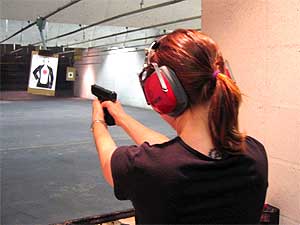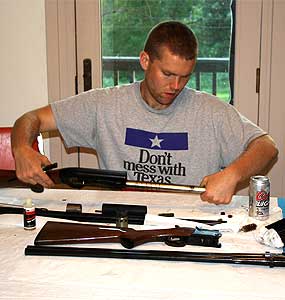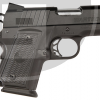Shooting and Lead Exposure (page 2 of 2)
Article Posted: May 6, 2013

Author: Carleton Edmunds, J.D | Article continued from page 1
Shooting at an Indoor or Outdoor Range
Firing a weapon generates a tremendous amount of heat and friction that can actually vaporize small amounts of lead with each shot. Those 'fumes' settle out on any cool surface where they also react with air and moisture to create easily transferable residues that can re-suspend in the air as lead dusts. Some Indoor ranges prohibit the use of non-jacketed bullets for this very reason. Some data suggest however that FMJ ammo with an exposed lead base can generate as much, or more lead vapor as properly-lubricated non-jacketed ammunition.
For these reasons, any indoor range you visit should have added ventilation to keep airborne lead under control. You should feel 'active' air movement at the firing line if the air exchange rate is adequate. Even with added ventilation lead vapors and dusts will accumulate to some degree on any exposed surfaces. You may want to consider a different range to shoot at if housekeeping is poor and ventilation seems sub-standard. The OSHA limit of 50 micrograms per cubic meter for lead applies to this type of setting where continuous exposure could be anticipated over an 8-hour work period.
Those lead dusts and vapors also accumulate on skin and clothing. Consider that the more people who are there shooting and the longer you are there, the more lead you will be exposed to. The rule is: Never eat, drink, or smoke when shooting indoors and wash hands thoroughly after shooting. These rules need to be observed all the time, even if they are not enforced by the range where you shoot.
An added precaution for indoor shooting is that lead may be in the form of dusts that can get on clothing and any shooting gear that is taken inside. ALARA requires changing into clean clothing as soon as possible once you're done. Even if you wash your hands after you get through shooting, they will quickly pick up more lead from the toxic dusts that have deposited on your clothes. Always make sure clothing gets washed before it is worn again. Jeans worn at the range on Saturday will still be contaminated with lead when you work out in the yard on Tuesday. The difference is you may not realize the lead hazards are still present. For more frequent shooters, wearing coveralls that can be donned and doffed at the range is an excellent way of protecting under-garments and makes good practice for all shooters if it will be a while before a change-out can occur.
Outdoor ranges provide the greatest safety with regard to lead exposure since ventilation is greatly improved. A down-side is that outdoor ranges pose a higher risk of environmental contamination as the amount of lead down-range and in backstops accumulate. Many modern ranges use lined backstops with earthen-fill or special traps to protect the surrounding environment from contamination by the lead-bearing soil. The accumulating lead constitutes a continuing environmental hazard as rain water percolates through the contaminated soil. Consider that our single 158 grain bullet fired from the .38 contains enough reactive lead to contaminate 175,000 gallons of water based on current action level of 15 parts per billion. That amount will fill more than four large swimming pools measuring 20 by 40 ft. Imagine then what the impact could be after you've fired just a few thousand rounds.
Some recommendations are to avoid 'plinking' that distributes lead indiscriminately. Find a safe backstop to fire into that will trap the lead. Over time, the sequestered lead can either be re-cycled or properly disposed of, reducing any long-term impacts to the environment. Protective clothing should be worn whenever reclaiming operations are undertaken to recover or remove the lead. Protective gear should include a minimum of respiratory protection and use of gloves to reduce exposure to the weathered lead.
Gun Cleaning
 After a day at the range, or in the field, proper care of your firearm means a thorough cleaning before placing it back into storage. The lead hazards may be more obvious here since they are more-logically associated with powder residues and other deposits left in the bore. Cleaning activities generally evoke less concern for lead exposure since the common use of specialty solvents and cleaners already prompts a need to protect hands without the further need for care. Here, the recommendation is to use disposable nitrile (blue) gloves during all cleaning operations. These will protect your hands from the organic solvents found in many cleaning solutions and will also provide a good barrier to lead. Avoid using latex gloves as these are generally porous to most organic solvents, offering little or no protection. Latex can also cause allergic reactions to some individuals. Eye protection is also recommended, not for the lead, but to protect the eyes from the harsh liquid chemicals and sprays that are used during cleaning.
After a day at the range, or in the field, proper care of your firearm means a thorough cleaning before placing it back into storage. The lead hazards may be more obvious here since they are more-logically associated with powder residues and other deposits left in the bore. Cleaning activities generally evoke less concern for lead exposure since the common use of specialty solvents and cleaners already prompts a need to protect hands without the further need for care. Here, the recommendation is to use disposable nitrile (blue) gloves during all cleaning operations. These will protect your hands from the organic solvents found in many cleaning solutions and will also provide a good barrier to lead. Avoid using latex gloves as these are generally porous to most organic solvents, offering little or no protection. Latex can also cause allergic reactions to some individuals. Eye protection is also recommended, not for the lead, but to protect the eyes from the harsh liquid chemicals and sprays that are used during cleaning.
Lead residues will concentrate at the muzzle and inside the bore - fouling. These residues are physically removed by bore brushes and special chemicals with chelating agents designed to remove and hold the lead deposits. Generally, cleaning to remove powder residues will be sufficient to remove the lead. Soiled cleaning materials should be collected in a clean disposable plastic bag and should be sealed in a manner that prevents any further contact with lead and chemical-soiled cleaning patches, rags, etc. used during cleaning.
Re-Loading
Re-loading activities present the same concerns that apply to handling lead bullets and ammunition. Bullet casting however, poses an additional concern because of the smelting operation that exposes the re-loader and the immediate surroundings to lead fumes and vapors. Lead melts at approximately 620 F and will vaporize at higher temperatures (e.g. >900 F). The 'fumes' that are generated will deposit quickly on any cool surfaces in the work area. If the deposits are not removed, the lead will react fairly quickly with the moisture in the air, creating toxic lead films and dust that act as sources of contamination after reloading is done. These residues are easily transferable, just as toxic, and carry the same concerns as contact with any other forms of lead.
CAUTION: Many older publications and even a few internet sources discuss melting lead on the kitchen stove. This is out-dated material and represents bad practice considering what we currently know about lead toxicity. Lead fumes generated during melting can easily contaminate food-preparation areas that can lead to elevated exposure and even poisoning.
Exposure is controlled by making sure there is adequate ventilation. This can be checked simply by striking a match and watching where the smoke goes when it is extinguished. Hold the match near the top of the production pot (melter). Sufficient ventilation will cause the smoke to visibly track away from the operator - either behind, or to either side of the pot. Preferably, a small fume exhaust should be placed toward the back of the furnace that exits the fumes to the outside. An old hair dryer attached to a length of plastic vacuum hose should be sufficient. Position the side air intake of the hair dryer where it will pull the smoke coming from the match.
Working outdoors will provide the best option if adequate ventilation is not available indoors. Avoid melting in confined areas and away from the kitchen or food preparation/storage areas. Use of a dust mask or filter-respirator is recommended along with heavy leather gloves to protect the hands from heat and direct exposure to lead and dross. Exposed surfaces should be limited to hard floors and walls that can be cleaned with a wet cloth or with a vacuum cleaner equipped with a high efficiency particulate air (HEPA) filter. Hand tools and other loose items should be stored to protect them from contamination with fumes and dust. The same cautions for exposure to other lead compounds are repeated - Never eat, drink or smoke while melting or handling lead, bullets, or dross during smelting operations. Wash hands, face and any other exposed skin as soon as possible, and again after the area has been cleaned up.
Properly dispose of the lead dross accumulated during melting. These are the light-colored impurities that are skimmed off the surface of the molten lead. These materials should not be handled without gloves and need to be collected in durable plastic bags that can be sealed to prevent further contact with the lead-bearing wastes. Quantities greater than ten pounds may require shipping and/or transporting as hazardous waste. Contact local health or environmental control offices if you have questions about disposal, as regulations may be more restrictive for businesses that generate larger quantities of waste.
SUMMARY
Controlling lead exposure is not difficult, and the key is always to keep exposures as low as reasonably achievable, ALARA. Understand that risk increases by the number of times we are exposed to lead and how much we are exposed to. Those risks are off-set by preventive actions that limit contact with the hands and mouth that reduce the amount of lead that can be ingested. Never eat, drink, or smoke when handing ammunition or when shooting at a range. Thoroughly washing hands and exposed skin after contact with toxic forms of lead breaks the main route of exposure. Changing clothes and cleaning up residues after the fact reduces chances of re-exposure.
Thanks to Ratha, and bhenak for use of the cc images.
Related Articles
Please like, share, favorite, bookmark, and comment. Thank You.
Original Articles
- New 25+1 Capacity Shotgun!
- Hudson H9 American Made 9mm
- How To Build A Mud Hut
- Pistol Looks Like Cell Phone
- 45 ACP vs 9mm Luger
- Best 9mm Carbines
- Mall Ninja Xtreme Zombie Carbine!
- 5 Alternative Range Bags for Pistols
- Best 45 ACP Carbines
- 5 Dirt Cheap Guns $170 to $260
- Muslim Free Shooting Range?
- How To Clean A Rifle
- 3 Good 300 AAC Blackout Reviews
- Top 5 Guns for Women
- How to Really Shoot A Pistol
- Worlds Best 9mm Handgun
- 5 Great Gun Safes (Options)
- 9mm vs 40 S&W Summary + Ballistics
- Red Oak, White, or Chestnut for Deer Herd?
- Bullets for Barter Post Collapse
- Funny Pro Gun Sayings
- 5 Strange Handguns You Don't Need
- 3 Great .22LR / 410 Survival Rifles
- American Rifles | The Original ARs
- 600 Round Glock Magazine
- 10mm vs 40 Summary and Ballistics
- How Important is "Shot Placement"?
- 10 Item First Aid Kit Checklist
- 10 Gun Lights for Home Defense
- How to Make a Stove Hobo Style!
- Most Basic Survival Food List Ever
- Best Handguns for Women
- Make Homemade Mosquito Trap
- Lets make a Sawed-Off Shotgun!
- Man Brings Knife to Gun Fight (Funny)
- Gun Store Etiquette (Proper vs Improper)
- 10 Simple Home Security Tips
- SIG-Sauer vs Glock
- Legal Length of Shotguns and Rifles
- 9mm Pocket Pistols
- Glock 17/19/26 Operating Procedures
- 10 Conceal Carry Tips (Funny)
- Understanding the 2nd Amendment
- Choose Your Own Crime Stats
- After You Dial 911 : Dont Be A Victim
- Does Gun Control Work?
- Best Shotgun Ammo for Self Defense
- Best Calibers for Self Defense
- FBI Handgun Ballistics
- 38 Special vs 380 ACP
- Top 5 Home Defense Handguns
- 5 Best Home Defense Shotguns
- How to Sight in a Scope - Step by Step Guide
- .380 ACPs Stopping Power (Funny)
- AK-47 vs AR-15 History and Facts
- A Bug Out Bag Checklist for 2015
- 30-06 vs. 270 Win
- Gun Stores
Ballistics Tools & Data
- Ballistic Trajectory Calculator
- Ballistic Coefficient Calculator
- 9mm Ballistics Chart
- 308 Ballistics Chart
- 30-06 Ballistics Chart
- .270 Win Ballistics Chart
- 30-30 Ballistics Chart
- 7.62x39mm Ballistics Chart
- 7mm Rem Magnum Ballistics Chart
- 17 HMR Ballistics Chart
- 223 Ballistics Chart
- .243 Ballistics Chart
- 22-250 Ballistics Chart
- Convert FPS to MPH









